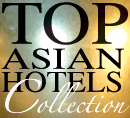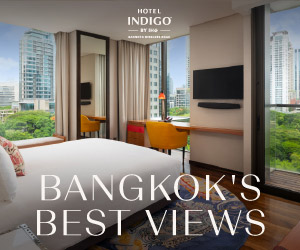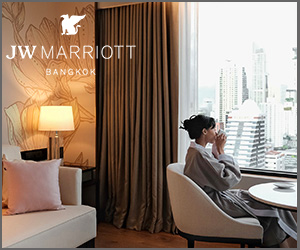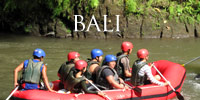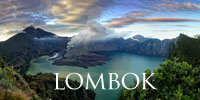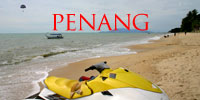|
ADVENTURE Chiang Rai frontier guide to beds and beasts, history and hedonismWith coffee replacing opium, visitors now chase the wild ghosts of the past — and some fine food — in a caffeine haze, across scenic hillsides bursting with flowers, colourful hill tribes, and posing elephants. ALERT: Late Sep 2024 rains and floods had shut several areas. The Legend Chiang Rai reopens in stages following renovations, from 1 November 2024. by William Mellor September 2024, Updated July 2025 SEE ALSO Bangkok shopping guide | Bangkok business hotels review | Bangkok new hotels review | Bangkok sky bars | Phuket fun guide | Phuket resorts review | Luang Prabang | Asian resort weddings | Vietnam resorts | Maldives resorts review | Mergui island guide | Chiang Mai fun guide 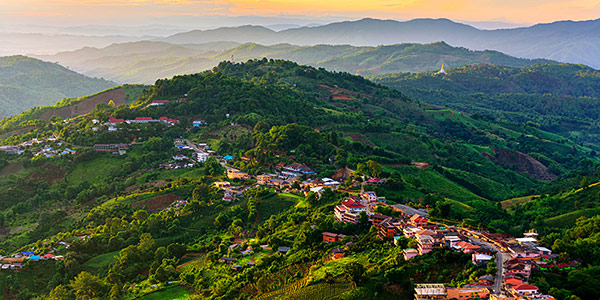
Sunrise over Doi Mae Salong, the wild frontier town a short drive from Chiang Rai that once achieved notoriety as an opium drug lord's stronghold. Now, instead of poppy fields, the hills are carpeted with coffee plantations and tea estates worked by Akha hill tribe women. JUMP TO Chiang Rai history and art | Quick hotel guide | Food, flowers, temples, hill tribes LUNCHING on wagyu short ribs and lobster while seated at a dining table that’s just been hoisted 52 metres into the treetops of Southeast Asia’s opium-growing Golden Triangle, my panoramic view spans two starkly different worlds. Almost immediately below my perch, the confluence of the mighty Mekong River and its tributary, the Ruak, marks the remote jungle-fringed spot where the borders of Thailand, Myanmar and Laos converge. Literally a stone’s throw away across the narrow Ruak lies Myanmar, a lawless no-go zone for tourists where drug warlords operate with impunity and resistance fighters battle a brutal military regime. But on the Thai side of the Triangle, I am securely cocooned within peaceful, tourist-friendly Chiang Rai province. Here at the five-star Anantara Golden Triangle Elephant Camp & Resort, guests are pampered with spa treatments between taking jungle walks with the pachyderms and their mahouts. They can also enjoy, as I did, gourmet meals in an open-air dining capsule attached to a discreetly concealed elevator that rises from the forest floor to the tree canopy to maximize stunning views of the two rivers and the mist-shrouded mountains beyond. And in the evening, they can transfer from their rooms and move into the jungle itself, where the resort has set up air-conditioned transparent Perspex bubbles complete with beds and ensuites to better observe the elephants throughout the night. 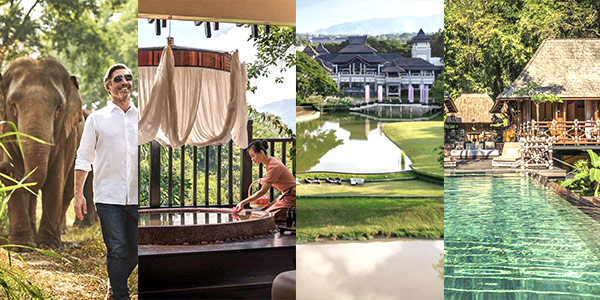
The Anantara Golden Triangle (far left and left centre) rolls out elephants and soothing spa treatments as part of its enticing offerings while (far right) the Four Seasons serves up a luxury tented camp. Meanwhile on the Kok River in Chiang Rai city, the Le Meridien (centre right) is an affordable and pleasant option. As for the proximity to the Golden Triangle’s wild frontier, that’s clearly no deterrent. On the contrary, visitors to the Anantara say the Triangle’s dark reputation merely adds a further frisson of excitement to their adventure. Chiang Rai, Thailand’s northernmost province centred on a regional capital city of the same name, isn’t the first place most people would think of when planning a trip to Southeast Asia’s favourite holiday destination. For a start, it is 1,600 kilometres from the beaches of Phuket and Koh Samui, and close to 900km from the bright lights of Bangkok. As for name recognition, novice Thailand trip planners have even been known to confuse Chiang Rai with the larger, similar sounding and more frequently visited city of Chiang Mai, a three-hour drive to the south, where the railway from Bangkok terminates. But for the discerning traveller, Chiang Rai is fast emerging as a go-to destination, with world class hospitality and attractions. Accessibility is also first rate, with multiple daily one-hour flights from both of Bangkok’s airports, Suvarnabhumi and Don Mueang, as well as a 90-minute nonstop hop from Phuket. Air Asia has set up a direct international service from Kuala Lumpur (from November 2024). Construction of a train line, due to open in 2027, is making rapid and visible progress. Within the province, roads are excellent and car hire options cheap and plentiful. From the airport pick up a fixed-price taxi from the ticket booth at around Bt400 (US$11.50) for the 20-minute 10km run to town. Local history and artTo be sure, tourism is not an entirely new phenomenon in Chiang Rai. Founded in 1262 by King Mengrai as the first capital of Lanna, a kingdom that long predates the Thai nation state, its ancient Buddhist temples, colourful hill tribes, magical mountain scenery and links to the opium trade have long lured niche devotees ranging from trekkers and other backpacking adventurers to the privacy-seeking ultrarich. Increasingly, though, Chiang Rai, while retaining that niche appeal, is drawing in a much broader-based tourism crowd. 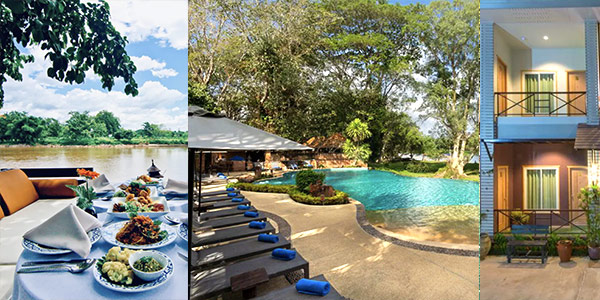
The Legend Chiang Rai Boutique River Resort & Spa (left and centre) is a homey spot for an unwind and much favoured by those in the know; (Far right) the unassuming Baan Jaru offers budget rates and is popular with long-stay guests who prefer a more downtown location. UNESCO recently recognized it as a “creative city of design.” And then, launching December 2023, the province hosted a hugely successful five-month-long arts festival, the Thailand Biennale, which attracted an astonishing 2.7 million visitors. Over the New Year period alone, international tourist numbers increased fourfold, according to data compiled by a local phone company. Anecdotally, I can attest to the destination’s ongoing popularity. During several post-biennale visits, Chiang Rai-bound flights have remained so close to capacity that, despite my relatively low Star Alliance frequent flyer status, I have actually received that rarest of Thai Airways perks: the unsolicited upgrade. So can Chiang Rai continue to accommodate such numbers? Absolutely. The city of 70,000 and surrounding 1,700sq km province is blessed, even by Thai standards, with myriad hotel and dining options at every price point. Chiang Rai hotels for all walletsAt the top end — both geographically and in price — the Anantara Golden Triangle Elephant Camp & Resort (www.anantara.com/) rates begin at around US$3,000 for a minimum two-night stay in a room or suite — with balcony and views over all three countries. While prices might raise a few eyebrows, there’s a reason the name pulls guests in. US-born and Thai-naturalised Bill Heinecke, who founded Anantara in Thailand and describes it as the flagship brand in what is now a 530-hotel, multi-label global portfolio, sets the highest of bars for his executives. From the first of several interviews I have done with Heinecke over the years, it was clear to me to me that he is passionate about both elephants and hotel spas — two of the Golden Triangle property’s key selling points. The experience on offer atones for the spend. While this Lanna-style architectural gem is easily accessible on good roads and can be reached in an hour from Chiang Rai airport, I would recommend taking the hotel’s “explorer” option of travelling first to the ancient Mekong river port of Chiang Saen, where an Anantara longtail boat awaits to whisk guests upstream to the entrance of the Ruak and finally the Anantara jetty. There, a welcoming committee of elephants and their mahouts greet new arrivals and escort them through the undergrowth to reception. 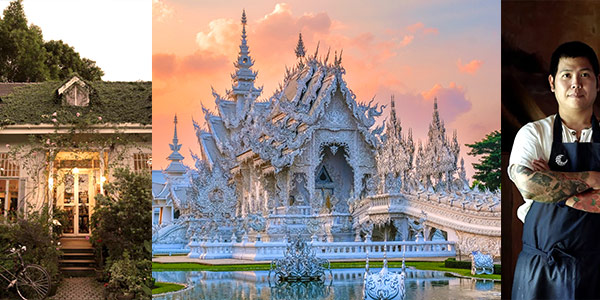
Chivit Thamma Da (far left) run by a former THAI flight attendant and her Swedish husband is a charming spot for a bite. Chef Kong (far right) runs the excellent Locus Native Food Lab (try his take on khao soi); and (centre) the stunning White Temple created by a prominent local artist is a major draw. The group owns an even more exclusive property next door, operated as the Four Seasons Tented Camp Golden Triangle (www.fourseasons.com/goldentriangle). This offers super luxury “glamping” at rates about double Anantara’s. The elephant experience is the same, the views similar. But the handful of spacious 54sq m tents with outdoor showers or wooden hot tubs offer another exotic, yet very different and even more private, option. Some 70km to the South, Chiang Rai city also offers international standard hotels — perhaps the best of them located on the south bank of the scenic Kok River, which rises in Myanmar and meanders through the centre of the provincial capital before turning north and emptying into the Mekong. Le Méridien Chiang Rai Resort (www.marriott.com) is set in lovely manicured grounds and boasts, in addition to good Thai food, an Italian restaurant, Favola, popular with locals as well as visitors. The buffet lunches, though, can be hit and miss. Still, at around US$100 a night, the rooms offer good value. Slightly upstream, the Riverie by Katathani (www.theriverie.com, the former Dusit Island Resort) also offers riverside accommodation of similar price and quality. I have enjoyed an occasional sundowner at the rooftop bar — said to be the highest in Chiang Rai. True or not, it offers majestic views north towards the giant white statue of Guanyin, the Chinese goddess of mercy, a striking Chiang Rai landmark. A third riverside option, and for me a personal favourite, is the Thai-owned four-star Legend Chiang Rai Boutique River Resort & Spa (thelegend-chiangrai.com). Managed by Eric Hallin, one of Thailand’s most experienced and knowledgeable hoteliers, the Legend’s accommodation ranges from double rooms at around US$55 a night to two-bedroom riverside villas with their own pools that go for around $200. With an exchange rate at around US$1=Bt34.97, that’s a lot less Thai baht to worry about. Like Le Meridien up the road, the Legend boasts an Italian restaurant with an excellent wine cellar. The evening happy hour attracts an interesting mix of expats as well as tourists. For visitors, Hallin — a Swede who has lived in Thailand since the 1970s — is a font of knowledge on Chiang Rai, and indeed Thailand. Several simple but comfortable local style options are available in the city centre, like the Nak Nakara Hotel (naknakarahotel.com) and the pleasant Mora Boutique Hotel (www.moraboutiquehotel.com) that takes a stab at design, both upwards of US$100. 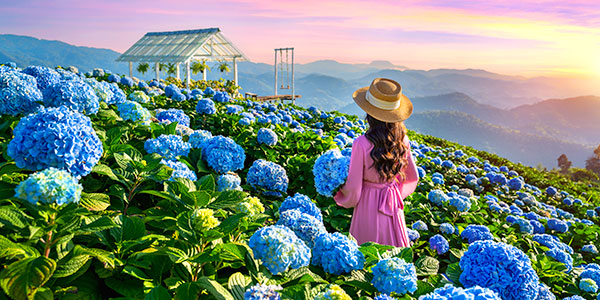
An hour's drive from Chiang Rai will bring you to spectacular flower gardens with violet and blue hydrangeas carpeting the slopes and more floral delights. Enjoy an Instagram pose, a bite and some magnificent hill views. Fancy something absolutely bargain basement? Wealthy Australian friends swear by Baan Jaru (www.facebook.com/baanjaru), a humble, friendly guesthouse in the middle of town, where rooms can be had for as little as US$25. Perhaps that’s why they’re wealthy. Or for those who simply can’t bring themselves to leave — and there are more than a few — modern one and two-bedroom condominiums with pools and club facilities sell for as little as US$50,000. That option is particularly popular with Hongkongers of a certain age who plan to spend at least part of their retirement here. Food, flowers, temples and hill tribesFood choices are equally eclectic. While I tend to head for stalls selling my favourite northern nam ngiow or khao soi noodles at around $1.50 a bowl, others may prefer to sample the cooking of Kongwuth Chaiwongkachon, a Bangkok-born chef who holds a Cordon Bleu grand diploma in French cuisine. Chef Kong, as he’s known, runs a chef’s table restaurant, Locus Native Food Lab (www.locusnativefoodlab.com), where he serves a set 11-course banquet featuring his interpretation of nam ngiow, khao soi and other traditional Chiang Rai dishes for $77 a head, or $170 with matching wines. Between the extremes of street noodles and chef’s table cuisine, Chiang Rai offers countless local and international food options. Yet despite the bewildering choice, almost every visitor seems to find his or her way to Chivit Thamma Da (The Simple Life, www.chivitthammada.com) a charming café, restaurant and bar on the opposite bank of the Kok River from the city centre. The owners, former Japan Airlines and Thai Airways International flight attendant Nattamon Holmberg and her Swedish-born businessman husband, Joakim, travelled the world before deciding there was no better place to enjoy a simple life than Chiang Rai. Visiting Chiang Rai is, however, not so simple for time-conscious tourists. With so many attractions, the first big decision may be what not to do. For many visitors, the priority will to head into the city to savour the hive of bustling markets, museums, galleries and temples that encircle the ornate central clock tower — a somewhat gaudy golden vision by day that at night changes colour on the hour in an unlikely chiming technicolour son et lumière performance. Already seen the Temple of the Emerald Buddha in the Grand Palace, Bangkok? Either way, don’t miss Chiang Rai’s serene 600-year-old Wat Phra Kaew, where Thailand’s most sacred image was first discovered in 1434 before eventually finding its way to the capital. 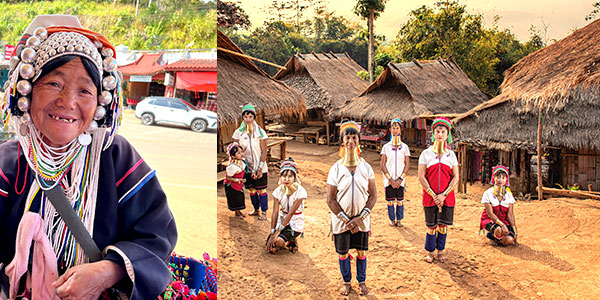
Akha lady at Mae Salong Market (left, photo: William Mellor); The traditional headgear is unmistakeable as hill tribe women work the coffee and tea plantations. (Right) Hill tribe refugees from Myanmar pose at the Longneck Karen Village. In complete contrast, a visitor can then follow the local crowds to at least one of the city’s recently built so-called art temples – preferably the controversial glittering white Wat Rong Khun, or White Temple, created by the province’s most famous living artist, Chalermchai Kositphipat. Or try the closer Wat Rong Suea Ten (Blue Temple). For a short 12km excursion, Singha Park (www.singhapark.com), a vast agritourism venture (with everything from cycling to rock climbing and ziplines) owned by the brewery of the same name, is a fine spot to stroll and watch the sun set behind the surrounding mountains – preferably while dining at the atmospheric Bhu Bhirom Restaurant. But while the provincial capital and immediate surroundings have much to offer, many of Chiang Rai’s charms and much of its fascinating recent opium-related history is best explored far beyond the city limits. The hills are literally alive. Walk through violet hydrangea blooms and assorted flower gardens (many offering spectacular mountain vistas within an hour’s drive from downtown Chiang Rai). Or motor up speedily north to a Longneck Karen Village where ring-bedecked refugees from Myanmar live in a touristy twilight zone caught between commercial ‘window display’ and the pursuit of evasive citizenship. For a more authentic hill tribe experience I would suggest the longer two-and-a-half-hour drive up past Doi Mae Salong towards the Myanmar border and the Akha and Lisu villages of Doi Hua Mae Kham (make a note of the November flower festival and the riot of sunflowers) and the closer Pha Hee. Much of this is coffee country, worked by Akha tribeswomen in their distinctive headdress. Storied Mae Salong is roughly midway between Chiang Rai and the Mekong-Ruak confluence where the three countries converge at the heart of the Golden Triangle. It is a an hour-and-a-half drive from downtown. A final series of hairpin bends lead to this mountaintop village, once the stronghold of a Chinese opium warlord named Tuan Shi-wen. In 1949, when Mao Zedong's communist forces won the civil war in China, most of the defeated Nationalist troops followed their leader, Chiang Kai-shek, into exile in Taiwan. But Tuan and remnants of the Kuomintang's 93rd Division fled in the opposite direction into Myanmar. From there, in 1961, they crossed into Thailand and settled at Mae Salong, where the slopes were carpeted with red and white opium poppies. 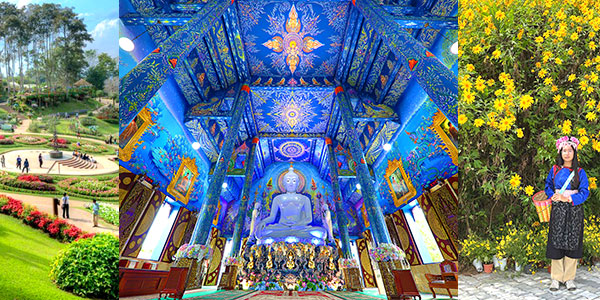
Doi Tung (far left) was transformed by the revered grandmother of the present King from an opium holdout to a spot for coffee plantations and exotic fruit. It is well worth a visit. The magnificent Blue Temple (centre) is another artistic marvel. (Far right, photo: William Mellor) A Lisu girl poses before a giant stack of sunflowers. Visit in November. Tuan then struck a deal with the Thais: He and his soldiers were allowed to set up their own opium-funded ministate in return for defending Thailand's northern borders from communist insurgents. Today, Mae Salong remains a mini-China within Thailand, with Mandarin and the Yunnan dialect widely spoken. In restaurants, Yunnan noodles are easier to find than tom yam goong. Tuan’s hillside mausoleum is now a tourist attraction, as is the nearby former headquarters of a rival drug kingpin, Khun Sa. But the poppy fields are long gone, replaced by profitable oolong tea and coffee plantations and welcoming resorts. How the transformation from opium production to profitable legitimate agricultural crops came about can perhaps be best understood by taking another mountain road to the royal villa of Doi Tung. There in 1988, Princess Srinagarindra, the then 88-year-old grandmother of Thailand’s present king, went to live to personally lead a royal initiative that resulted in thousands of hilltribe farmers abandoning opium poppies for tea, coffee and exotic fruits. The royal villa and an adjoining museum is open to the public and well worth a visit. Doi Tung is far from the only place where crop substitution has succeeded spectacularly. Another mountain community, Doi Chang, has become synonymous with the excellent coffee found in the cafes of Chiang Rai and far beyond. Doi Chang is an hour and 20 minutes from Chiang Rai and home to an Akha cooperative so photo opportunities will abound. “Doi” is the northern Thai word for mountain and Doi Nang Non, or Mountain of the Sleeping Lady, should also not be missed. Shaped like a reclining woman and, according to legend, haunted by the ghost of a princess who killed herself after an ill-fated love affair, it is the site of the Tham Luang cave, where in 2018 divers miraculously saved 12 boy footballers and their coach who had been trapped for 18 days in the flooded caverns. Sure, you’ve seen the Hollywood films and streamed the mini-series about the international rescue, but to actually venture into the cave entrance adds another dimension to this inspiring story. Chiang Rai isn’t the perfect year-round holiday destination. Before visiting, you have to choose your dates with care, preferably avoiding parts of March and April when agricultural burning spreads an unhealthy haze across much of northern Thailand, including Chiang Mai. But once the rains fall, the air clears, returning the province to its lush best. And tourists once again savour the frisson of excitement that accompanies an exploration of Thailand’s wild northern frontier.
NOTE: Telephone and fax numbers, e-mails, website addresses, rates and other details may change or get dated. Please check with your dealer/agent/service-provider or directly with the parties concerned. SmartTravel Asia accepts no responsibility for any inadvertent inaccuracies in this article. Links to websites are provided for the viewer's convenience. SmartTravel Asia accepts no responsibility for content on linked websites or any viruses or malicious programs that may reside therein. Linked website content is neither vetted nor endorsed by SmartTravelAsia. Please read our Terms & Conditions. |
